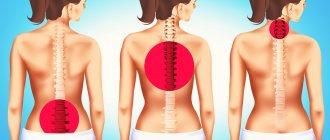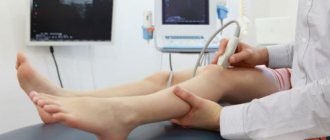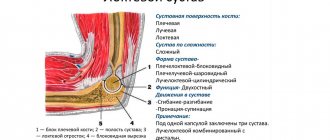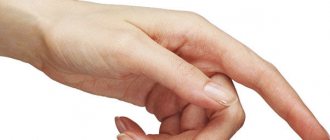There are several reasons why your hand hurts in the wrist area. These are injuries with unexpressed symptoms, tendinitis, peritendinitis, tendovaginitis, osteoarthritis, tunnel syndrome, hygroma, arthritis, synovitis, as well as stress on the hands due to professional activities. You should consult a doctor in a timely manner and undergo a course of treatment, adhere to preventive recommendations.
Causes of wrist pain
There are many reasons that can lead to wrist pain. They are divided into two large groups: physiological and pathological.
Physiological
Often, painful sensations in the wrist occur for reasons that do not have a pathological basis.
These include:
- Leaving your wrist in an awkward position for too long.
- Hereditary weakness of the ligaments of the hand.
- Long-term alcohol abuse.
- Taking medications without medical supervision. In this regard, drugs for the treatment of epilepsy are especially dangerous.
- Working on the keyboard.
- Features of professional activity. At risk are crane operators, drivers, carpenters, mechanics and construction workers who interact with jackhammers.
- Participation in certain sports: tennis, golf, performing exercises with a barbell, rowing.
- Carpal tunnel syndrome. It often occurs in pregnant women. This happens in the 2nd and 3rd trimester. The reason for its development is rapid weight gain. The syndrome manifests itself with symptoms such as: pain, numbness of the hand. The pain is especially intense during night rest.
Pathological
Pathological causes that can lead to wrist pain include:
- Tumors located on the arm.
- Injuries received. Pain occurs due to a dislocation, fracture, bruise, rupture or sprain. In the area of damage, swelling forms and hematomas appear. All this increases the pain.
- Arthritis. Joints can be affected for various reasons. This includes infectious factors, as well as aseptic inflammation. Arthritis is one of the common causes of wrist pain.
- Arthrosis. This disorder can occur after a joint injury. Pain appears during exercise. At rest it is absent.
- Tenosynovitis or de Quervain's disease. This pathology develops in people who often perform the same type of joint movements. Pain occurs when the hand is abducted. It radiates to the thumb and elbow.
- Tunnel syndrome. It develops against the background of wear and tear of the tendons, as well as inflammation of the nerve fibers. People who work at a computer often suffer from carpal tunnel syndrome.
- Tendinitis. The disease occurs due to excessive stress on the wrist. Professional athletes often suffer from tendonitis.
- Gout. With this disease, excess amounts of uric acid or calcium salts accumulate in the joints. Exacerbation of the pathology is accompanied by intense pain, burning sensation, and pulsation in the affected area.
- Osteoarthritis. The pathology most often affects people aged 40-60 years. The disease is characterized by the destruction of bone tissue. Moreover, it can suffer anywhere, and not just in the area of the metacarpophalangeal joint.
- Erythema nodosum. With this disease, adipose tissue becomes inflamed. Tumor-like neoplasms form in the affected area. The skin over them turns red, and they feel painful when touched.
- Brucellosis, gonorrhea and other diseases of an infectious nature.
- Tuberculosis of joints and bones. This disease rarely develops. It mainly affects older people. Most often, the spine, which experiences excessive stress, is affected. However, bone tissue can be damaged anywhere in the body.
- Peyronie's disease. A person experiences pain in the wrist. Only men suffer from this disease.
- IHD and myocardial infarction.
- Trigger finger.
- Ganglion or hygroma. With this disorder, bumps form under the skin. They will contain liquid that has the consistency of jelly.
- Kienbeck's disease.
- Spinal diseases. Many of them lead to compression of the roots and spinal nerves. This causes pain in certain areas of the body.
- Volkmann's contracture. With this disorder, the patient experiences obstruction of the ulnar artery.
The development of a particular pathology can be determined by the location of the pain. Often, painful sensations in the wrist can be caused by disorders such as:
- Damage to the central nervous system.
- Spinal diseases.
- Rheumatoid arthritis or arthrosis.
- Bone cracks or ligament damage.
Symptoms and possible diseases
Wrist pain is the main symptom that will always be present. The person may also experience other signs of the disorder. They depend on the specific disease that caused the wrist pain.
Common symptoms include:
- Numbness in the palm and hand.
- Goosebumps.
- Burning and itching in the affected area.
- Trembling fingers, tingling in fingers.
- Increased pain at night, after intense physical activity.
- Crunching in a characteristic area.
- Weakness of the fingers when trying to grasp any object.
- Limitation of hand movements.
- Swelling in the fingers and palms. It can occur on one or both limbs.
Specific symptoms
Specific symptoms of wrist pain include:
- General deterioration in health.
- Hyperemia of hand tissues. Redness often appears after an injury.
- Anatomically incorrect position of the limb (after a fracture). Joint instability (after dislocation).
- Hemorrhages under the skin (after an open fracture).
- Pain when bending a limb.
- Joint deformity.
- Inability to perform any actions with the affected hand.
- Shortness of breath, pain in the chest and heart area.
- Burning, itching, tingling of the limb.
- Hyperemia of the skin, which is located above the affected area.
- Increased body temperature.
- Muscle weakness.
The listed symptoms are more common than others. They can accompany acute and chronic wrist pain. The exact clinical manifestations depend on the specific pathology that caused the pain syndrome.
Knee crunches. Diseases and injuries that cause joint cracking
Crunching in the knees occurs due to the following diseases:
- Gonarthrosis. Characterized by wear and tear of cartilage tissue and subsequent deformation of the joint. Often leads to disability. More common in women.
- Rheumatoid arthritis. It is expressed in the form of chronic inflammation of the knee joint and damage to the synovial membrane. The disease is provoked by excessive physical activity, frequent knee injuries, and hypothermia.
- Chondromatosis. Most often, one knee joint is affected. Sometimes the disease can develop into a malignant tumor, but very rarely.
- Bursitis. This disease occurs from injury to the knee, resulting in inflammation of the synovial bursa. Bursitis appears after knee injuries. Excessive exercise can also cause the disease.
- Osteochondritis. The cartilage plate that protects the bone gradually peels off. The disease is detected at the age of 20-40 years, mainly in men.
- Hypermobility syndrome. The problem is excessive active joint mobility and flexibility.
Knees crunch when bent not only due to diseases, but also due to injuries:
- Damage to the menisci. This problem most often occurs after unsuccessful jumps, sharp turns of the shin, as well as sharp extension of the knee.
- Dislocations. Violation of the functionality of the joint leads to clicks, which indicate displacement of the articular surfaces.
- Fractures. Due to injuries to the hip, shin and patella, clicks appear in the knee area.
- Ligament injuries or sprains. They occur due to excessive stress on the joints. The anatomy of the joint is disrupted, so a click appears when moving.
When is it necessary to see a doctor?
A doctor should be contacted immediately if a person experiences symptoms such as:
- Loss of sensation in fingers.
- Painful sensations persist for several days.
- After putting pressure on the arm, the pain becomes stronger.
- The wrist is deformed.
- Swelling or thickening forms in the affected area.
- The person cannot move the limb.
- The pain gets worse when you move your arm.
- When you try to move the brush, you hear a crunching and squeaking sound.
Prevention
Preventive measures are necessary, especially if there is a possibility of styloiditis occurring in connection with professional activities:
- do not make sudden movements, use the entire hand to grasp the object;
- warm up muscles before physical education or sports;
- wear special gloves when working with vibrating tools;
- when working with a computer, rest every hour for 5 minutes, stretch your fingers and hands;
- the position of the body and hands at the computer should be as natural as possible;
- do special exercises if work involves a risk of developing a disease;
- try not to do monotonous work for a long time without a break.
If prevention is not carried out, the likelihood of developing styloiditis of the wrist joint increases.
There is no need to turn a blind eye to pain: identifying the problem in the initial stages will help you get rid of it quickly and without problems. Depending on the form and severity of the disease, the doctor will select suitable treatment methods. At the initial stage, you can easily and quickly get rid of styloiditis using shock wave therapy without surgery.
Which doctors should you consult if your wrist hurts?
To find out the cause of wrist pain, you need to contact such specialists as:
- Therapist
- Traumatologist.
You should visit a doctor after an injury, regardless of its origin. If it is not possible to get to a traumatologist, then you need to go to see a surgeon.
- Orthopedist.
A doctor is consulted when, in addition to pain in the wrist, a person notices swelling in a characteristic area, and when moving, a creaking and crunching sound is heard. Pain may also occur when moving the thumb and index finger. These symptoms indicate peritendinitis.
- Rheumatologist.
Symptoms that should force a person to contact this specialist: paroxysmal pain (they can last from several hours to several days), redness in the joint area, local increase in body temperature. When a joint becomes deformed after the end of an attack of pain, gout or pseudogout can be suspected. Other signs may indicate a systemic disease: rashes on the skin and mucous membranes, a burning sensation when emptying the bladder, an increase in body temperature up to 37.5 °C, chills, headaches, weakness, sweating during sleep. These symptoms are also characteristic of infectious arthritis. It can be caused by gonorrhea, tuberculosis, brucellosis.
- Neuropathologist.
This doctor will provide care to a patient with carpal tunnel syndrome. It often develops in pregnant women and in people who work at a computer. The development of this pathology is indicated by symptoms such as: pain, burning and itching in the wrist, trembling in the fingers (all fingers suffer except the little finger). It is difficult for a person to hold an object in the palm of his hand. The hand may swell, and numbness often occurs in the forearm area. The hand becomes cold and skin sensitivity worsens.
If it is difficult for a person to understand which doctor he needs to see, then first he should visit a therapist.
Diagnostics
After visiting a doctor, the patient will have to undergo diagnostic procedures such as:
- Anamnesis collection.
The patient must describe the symptoms that bother him as accurately as possible. It is important to clarify the location of the pain, its nature, and area of distribution. If you have previously been injured, you should report this to a specialist.
- Physical
examination.
The doctor will examine the affected area, assess the presence of swelling, deformities, hematomas, bone displacement, and inflammation. - Donating blood for clinical and biochemical analysis.
This will allow you to assess the severity of inflammation.
- Ultrasound of the joint. This
The study allows you to diagnose synovitis, arthritis, tendinitis.
- X-ray of the joint.
With its help, dislocations, fractures, inflammatory processes, synovitis, and carpal syndrome are detected.
- Arthroscopy.
A microscopic camera is inserted into the joint, as well as instruments to eliminate pathology. This procedure is carried out not only for diagnostic, but also for therapeutic purposes.
- Assessment of electrical activity of nerve trunks
(electroneurography) and muscles (electromyography).
- CT or MRI.
These studies make it possible to accurately determine pathological changes in tissues. Using CT and MRI, disorders such as bone necrosis, fractures, arthritis, damage to nerve fibers and soft tissues of the limb, inflammation of tendon sheaths are detected. However, not everyone can undergo an MRI. This examination is not prescribed for patients with a pacemaker, with claustrophobia and pregnant women.
- Scintigraphy.
A special substance is injected into the tissue. When it accumulates, the doctor examines the affected area using a gamma camera. Scintigraphy makes it possible to diagnose avascular necrosis of bone tissue, arthritis, fractures and synovitis.
- Study of the composition of synovial fluid.
A special device is inserted into the joint, with the help of which the joint fluid is collected. Then it is examined for pathogenic flora.
Treatment for wrist pain
A comprehensive therapeutic effect on the body will allow you to achieve a speedy recovery.
Treatment is carried out in the following areas:
- Fixation of the damaged area. The patient may be given a plaster cast, splint, or other fixative.
- Treatment with physiotherapy methods.
- Performing exercise therapy, visiting a massage therapist’s office.
- Taking medications.
Surgery is resorted to in extreme cases.
Drug therapy
There are many drugs that can cope with diseases of the wrist joint. Most of them help against a specific pathology. They should be prescribed by a doctor after he knows the patient’s exact diagnosis.
The main groups of medications that can be used to treat wrist pain:
- Analgesics:
Ketonal, Ketanov, etc.
- NSAIDs:
Larfix, Ortofen. They are used in the treatment regimen for arthritis and osteochondrosis.
- Chondroprotectors:
Artra, Teraflex. They are used to restore the patient's lost range of motion. The drugs can be prescribed either in the form of tablets or ointments.
- Antirheumatic
drugs:
Arva, Imuran. They are prescribed in order to prevent dystrophic and degenerative processes in articular tissues. - Calcium preparations:
Calcemin. They are prescribed to patients with impaired bone tissue integrity.
- Corticosteroids:
Prednisolone, Celeston. These drugs are used to relieve pain caused by arthritis and arthrosis.
- Combined drugs.
This includes Dolobene gel. Its use can reduce tissue swelling, relieve inflammation and pain. You can also use the drug Diclak, which helps reduce body temperature and also has an antirheumatic effect.
Experts prohibit patients from taking any painkillers and anti-inflammatory drugs until a diagnosis is made. Otherwise, it will be difficult to make an accurate diagnosis. If it is impossible to endure the pain, then it is permissible to take a Ketanov tablet and immediately consult a doctor.
Physiotherapy
If the pain in the wrist was caused by an injury, then the doctor may prescribe physiotherapeutic treatment to speed up tissue restoration. These procedures help to enhance nutrition of the affected area, and also enhance the therapeutic effect of the drugs used, for example, ointments or creams. Thanks to physiotherapy, it is possible to remove salt deposits from the joints.
The most prescribed procedures:
- Ultrasound treatment.
Effects: improved blood and lymph flow, elimination of inflammation, improved permeability of the dermis, effective penetration of ointments and gels into the affected tissues. Thanks to this treatment, recovery is rapid.
- Magnetotherapy.
Effects: reducing the intensity of the inflammatory process, relieving pain, relieving swelling.
- Electrophoresis.
This procedure is prescribed for various diseases that are accompanied by inflammatory phenomena.
- Laser treatment. Effects
: stimulation of metabolic processes, improvement of blood circulation, removal of excess salts, pain relief.
- Applications with paraffin.
They are prescribed for tendon damage, namely chronic tendinitis.
- Shock wave therapy.
This procedure is often prescribed to patients who require surgery. Sometimes, thanks to shock wave therapy, surgery can be avoided. This treatment is indicated for patients with trauma.
After completing a full treatment course, a person gets rid of pain. The average number of procedures is six. The duration of one session is 20 minutes. During treatment, you should not engage in sports; it is important to avoid putting stress on the joint.
Physiotherapy
Physical therapy complexes allow you to cope with various joint pathologies. Thanks to well-chosen exercises, it is possible to restore the range of lost movements and strengthen the muscles. Classes must be carried out under medical supervision.
It is important to ensure that the person does not experience pain while performing the exercises. If discomfort occurs, exercise should be stopped. You can perform simple exercises on your own, but they must be recommended by a doctor. You can use a special massage ball. The load on the hand should not be too intense.
Massage
If a person suffers from chronic joint disease, then massage is indicated for him. It promotes normal lymph flow, eliminates pain, and improves tissue nutrition.
Massage can only be performed by a specialist with medical education. If a person has not been trained in professional massage, then it can harm the patient’s health.
Surgical treatment
Surgery is prescribed when conservative methods fail. Sometimes the help of a surgeon is resorted to in order to restore a joint after an injury.
The operation is performed under anesthesia. The altered articular structures are removed, tendon aponeurosis is performed and sutures are applied. Rehabilitation takes up to 3 months. It all depends on the volume and nature of the intervention.
Diet therapy
To keep your joints healthy, you need to include foods rich in vitamin D and calcium in your diet. These include: yogurt, cheese, milk, broccoli, rich green vegetables.
It is beneficial to eat fatty sea fish and nuts, as they are a source of omega-3 fatty acids. During pregnancy, you need to monitor your weight and prevent the formation of edema. To do this, you need to eat right and drink enough water.
Alcoholic drinks are excluded. They negatively affect the condition of joints and bones. Men should not drink more than 2 servings of alcohol per day, and women should not drink more than 1 serving. To reduce the likelihood of developing osteoporosis, you need to give up tobacco. In addition, smoking interferes with normal tissue repair after injury.
Video: Physical Therapy by Jeff Cavaliere. About the causes of wrist pain, hand anatomy and exercises to eliminate pain:
First aid
For mild to moderate bruises, first aid is usually not required. In case of severe injury, the patient is given first aid, the correctness of which often determines the speed of recovery.
Algorithm of action for a bruised wrist:
- Inspect the bruised surface for an initial assessment of the extent of the damage.
- If there is no violation of the integrity of the skin, apply ice for 10 minutes to prevent swelling and pain. For cold, you can use a hypothermic first aid bag or a cloth soaked in cold water.
- Apply a pressure bandage to your hand using an elastic bandage. Fix your hand at a right angle using a scarf.
- If the pain is severe, give the victim an analgesic (Baralgin, Ketanov) and take him to a trauma center.










